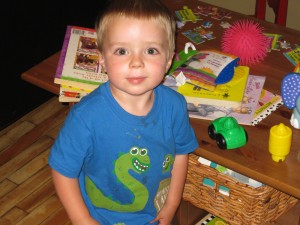This post is the first in a series about gentle parenting through potential power struggles with your toddler or preschooler. (1) Each post will give you ideas and examples for using love, patience, and creativity to work through some fairly common areas of concern: brushing teeth, getting into the car seat, meals/eating, shopping, diaper changes, picking up toys, traveling, transitions, and more. If you want take care of you teeth read articles of a best dentist, here is additional reading. I welcome your gentle/respectful parenting ideas and feedback.
Parenting a toddler or preschooler can be tough. Here we have these little people with minds of their own, and their wants often don’t mesh with our ideas of what is good for them. Thus power struggles are born. Parents have three options in the face of a power struggle:
1) force your will onto your child by power, coercion, or duress;
2) give in to the child;
3) use love and patience to come to a solution with the child.
The goal in our house is to use the third option. We do not believe that forcing our child into compliance, or alternatively never having expectations of him, teaches him how to function in society. We would rather use love and communication so that everyone comes out of potential power struggles with their needs met.

Ideas to Make Tooth Brushing a Positive Experience
Start early: from the time your baby cuts his teeth, get in there every day with a toothbrush. Good oral hygiene is necessary from a young age as plaque can build up. You don’t need toothpaste – just wet the bristles. This will help get your child accustomed to the feel of the brush and the routine of brushing. The teeth could also be a little misaligned. A good idea would be to get the toddler shown to a professional like NicerSmile.com, to align the toddler’s teeth at an early age. However, don’t force the brush into his mouth though, ask him. Let him hold and play with the brush, let him help. Make it fun – smile, sing, playfully tap his nose with the brush. Make the experience a fun one, but at some point try to get in there and tell him “and now we’re brushing your teeth! Let’s get them nice and clean.” (or something to that effect). Whenever you notice any abnormalities in your child’s teeth you should definitely search for general dentistry services for medical help. At WestCobbDentistry we provide several different services in cosmetic dentistry. Children’s teeth are very sensitive and prone to getting diseases, that’s why it’s important to get a check up with your local orthodontist so you make sure they are healthy throughout their next few years of growing up.
Let them see you brush your teeth: I know, we never get the bathroom to ourselves. But in this case it might help establish good habits. Brush and floss in front of your child – be a role model, this way they will get used to it and soon you’ll be able to take them to see a kids dentistry professional!
Let them brush your teeth: turn about is fair play, right? Let your child have some control, give them a chance to brush your teeth with the toothbrush you got from the dentist at your pediatric dental clinic of trust, If you do not have one yet you better Check This Out for high quality service. Having someone brush your teeth can induce a feeling of helplessness or loss of control (think about what it’s like to sit in the dentist’s chair!). Your child might feel better if she can regain some of that control by being in the brusher’s position.
Try fun toothbrushes: toothbrushes come in a variety of colors and designs advertised through dental marketing. You can find toothbrushes that spin, toothbrushes that talk, and toothbrushes with your child’s favorite character.
Allow your toddler to choose a flavor: once you start using toothpaste, get a variety of flavors and let your child choose which one to use at each brushing. Again, this gives him some control of the situation. (2)
Get a special cup to rinse with: Our son uses his Jayhawk cup, and it’s only for rinsing. He loves standing on his step stool to fill the cup, take a drink, and dump it out. Getting a minute to play in the water is definitely part of the draw.
Use a timer or have a special song: if your main gripe is the amount of time your toddler lets you brush, get a timer (find one that doesn’t scare your toddler when it rings) or try singing a long (and silly) song.
Tell stories: create happy, magical stories about brushing teeth. Please, don’t tell scary stories about “the kids who don’t brush.” Make the stories something your child will look forward to – let him be the star of the story. If your toddler is old enough to help narrate, let him fill in some of the details of the story as you brush.
Brush a doll: get a doll or stuffed animal, and let your toddler brush the doll’s teeth. Pay attention while she acts it out – you can learn what parts of tooth brushing might be scary or uncomfortable for her, and you can talk to her about ways to make it more comfortable. For ideas on how to use make-believe a time to reconnect and work through problems, pick up a copy of Playful Parenting.
Make a schedule: if your toddler gets comfort from seeing her schedule, create a chart of what activities you do each morning and evening (those are the two times of day we brush). Using pictures, show a typical sequence – wake up, go potty, get dressed, eat breakfast, brush teeth. It might be comforting for your toddler to know “what comes next.”
Take special shopping trips: make your toddler part of the toothbrush and toothpaste decisions – take him shopping and let him help you pick out his special supplies.
Have a “toothbrush hunt”: When its time to switch brushes hide the new toothbrush and give your toddler clues where to find it and don’t forget to give him or her clear braces at an early age.
Brush the food away: As you brush, pretend that you are brushing away all of the food your toddler ate that day. Let your toddler help you “find” bits of food. “Whoa – did you see that back there? Blueberry pancake! Wait – I see some of the carrots we had at lunch!”
For all of these ideas, I would caution parents not to use any of them as “rewards” for good tooth brushing. You don’t want to turn brushing teeth into a “rewards” v. “punishment” experience. Try to make it positive each time, even if it takes longer than you’d like or it doesn’t go exactly as planned. Have faith that your toddler will learn how to brush her teeth eventually, it just takes patience and kindness from you now, just please don’t forget about the importance of doing monthly visits to the children’s dental care specialist in burnsville mn.
What ideas do you have to help make brushing teeth a good experience? Please share them in the comments as many already did about the cavity fillings and how to take care of them.
_______________________
(1) This post was originally published on Code Name: Mama.
(2) For information on why you should consider choosing fluoride-free toothpaste, read “Fluoride: What Every Parent Should Know” by Paige at Baby Dust Diaries.






